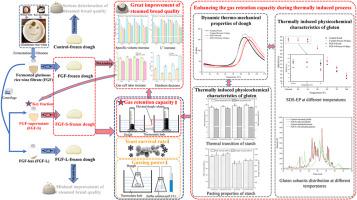发酵米酒滤液对冻面馒头品质的改善——对面筋和淀粉热致理化特性的探讨
IF 11
1区 农林科学
Q1 CHEMISTRY, APPLIED
引用次数: 0
摘要
研究了发酵糯米酒滤液(FGF)及其组分(上清、FGF- s、酒糟、FGF- l)对冻面馒头(FDSB)品质的影响,并探讨了其在蒸制过程中提高面团保气能力的机理。FGF和FGF- s显著提高了FDSB的比容、重量和气池比,显著降低了FDSB的硬度。FGF-L富含微生物,但缺乏关键代谢物,与对照组相比,FGF-L未能显著改善FDSB的质量。FGF和FGF- s显著提高了冷冻14 d后的面团体积和气保率。动态热力学分析表明,FGF-S显著提高了面团的Tonset和Tpeak,有效延缓了淀粉糊化和气细胞破裂。根据蛋白SDS的可提取性和亚基分布结果,FGF-S抑制麦胶蛋白中麦胶蛋白的释放和高分子量麦胶蛋白亚基向低分子量麦胶蛋白亚基的解聚。同时,FGF-S在蒸制初期(<65℃)增强了面筋的聚合和气体潴留,防止了后期(≥90℃)面筋网络过于致密的形成。不同温度下的反相高效液相色谱结果证实,在超过90℃的温度下,FGF-S抑制麦胶蛋白和谷蛋白亚基之间的热诱导交联。此外,FGF-S延缓了淀粉的热转变和糊化,降低了糊化粘度,促进了气细胞的扩散和膨胀。作为一种清洁标签成分,FGF在冷冻面团中具有很强的应用潜力。本文章由计算机程序翻译,如有差异,请以英文原文为准。

Improvement on the quality of frozen dough steamed bread by fermented glutinous rice wine filtrate: Insights into the thermally induced physicochemical characteristics of gluten and starch
This study investigated the effects of fermented glutinous rice wine filtrate (FGF) and its fractions (supernatant, FGF-S; lees, FGF-L) on the quality of frozen dough steamed bread (FDSB), and explored the underlying mechanisms in enhancing dough's gas retention capacity during steaming process. FGF and FGF-S significantly increased the specific volume, lightness, and gas cell ratio, and significantly reduced hardness of FDSB. FGF-L, rich in microorganisms but lacking key metabolites, failed to significantly improve the quality of FDSB compared with the control group. FGF and FGF-S significantly increased elevated dough volume and gas hold ratio of dough after 14 days of frozen storage. Dynamic thermo-mechanical analysis showed that FGF-S significantly increased Tonset and Tpeak of dough, indicating effective delay in starch gelatinization and gas cell rupture. According to the results of protein extractability in SDS and subunits distribution, FGF-S inhibited the release of gliadin from gluten protein and depolymerization of high molecular weight glutenin subunits to low molecular weight glutenin subunits during frozen storage. Meanwhile, FGF-S enhanced gluten polymerization and gas retention during the initial stage (<65 °C) of steaming while preventing formation of overly dense gluten network at the later stage (≥90 °C). Results of reverse-phase-HPLC at different temperatures confirmed that FGF-S inhibited thermally induced cross-linking between gliadin and glutenin subunits at temperatures exceeding 90 °C. Moreover, FGF-S delayed thermal transition and pasting of starch, reduced pasting viscosities, and facilitated diffusion and expansion of gas cells. As a clean label ingredient, FGF holds strong potential for use in frozen dough.
求助全文
通过发布文献求助,成功后即可免费获取论文全文。
去求助
来源期刊

Food Hydrocolloids
工程技术-食品科技
CiteScore
19.90
自引率
14.00%
发文量
871
审稿时长
37 days
期刊介绍:
Food Hydrocolloids publishes original and innovative research focused on the characterization, functional properties, and applications of hydrocolloid materials used in food products. These hydrocolloids, defined as polysaccharides and proteins of commercial importance, are added to control aspects such as texture, stability, rheology, and sensory properties. The research's primary emphasis should be on the hydrocolloids themselves, with thorough descriptions of their source, nature, and physicochemical characteristics. Manuscripts are expected to clearly outline specific aims and objectives, include a fundamental discussion of research findings at the molecular level, and address the significance of the results. Studies on hydrocolloids in complex formulations should concentrate on their overall properties and mechanisms of action, while simple formulation development studies may not be considered for publication.
The main areas of interest are:
-Chemical and physicochemical characterisation
Thermal properties including glass transitions and conformational changes-
Rheological properties including viscosity, viscoelastic properties and gelation behaviour-
The influence on organoleptic properties-
Interfacial properties including stabilisation of dispersions, emulsions and foams-
Film forming properties with application to edible films and active packaging-
Encapsulation and controlled release of active compounds-
The influence on health including their role as dietary fibre-
Manipulation of hydrocolloid structure and functionality through chemical, biochemical and physical processes-
New hydrocolloids and hydrocolloid sources of commercial potential.
The Journal also publishes Review articles that provide an overview of the latest developments in topics of specific interest to researchers in this field of activity.
 求助内容:
求助内容: 应助结果提醒方式:
应助结果提醒方式:


